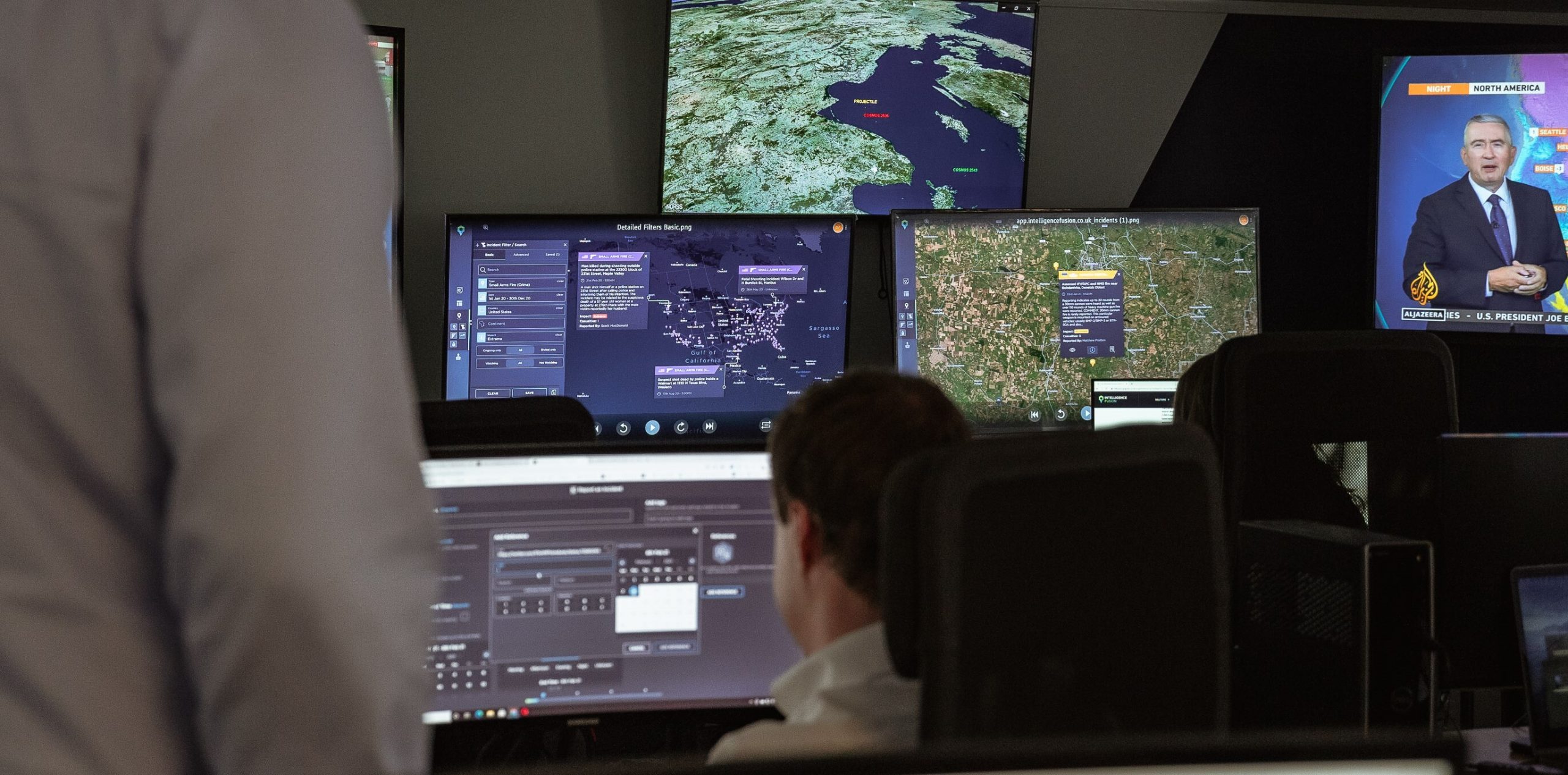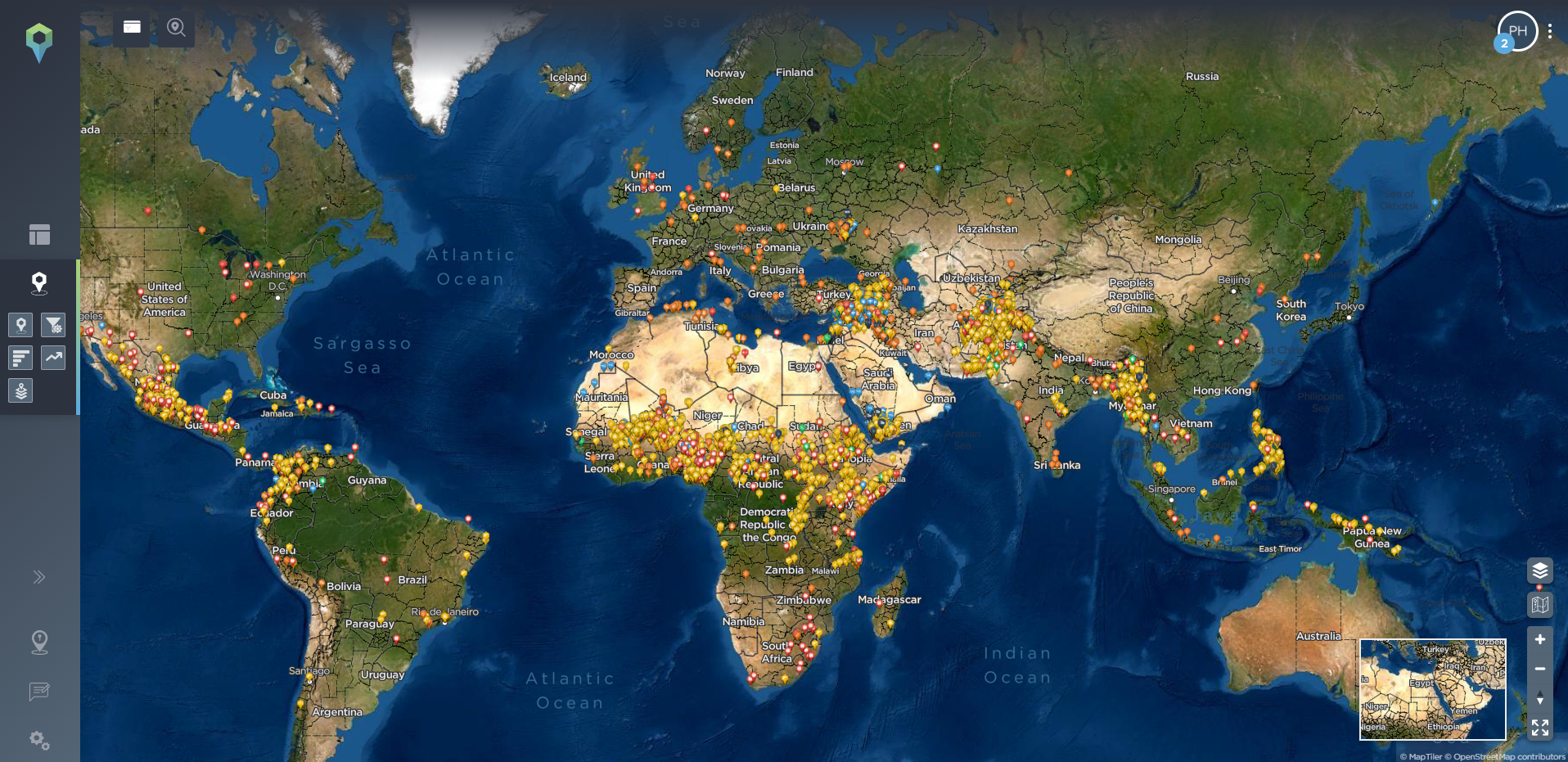Security outlook for crime and violence in Medellin for 2022
Despite progress being made in the region, security and crime in Medellin, and the wider Antioquia department in Colombia, remains a key concern for 2022.
What's happening in Medellin, Colombia?
In December 2021, the Department of Antioquia, and its capital Medellin, were given the award for having the best Development Plans in the country by the National Planning Department. The award was given due to Medellin’s plans and commitments to projects that will held reactivate the economy, which took a downturn due to Covid-19, while the department itself received recognition for its proposals to solve problems such as climate change, food insecurity and wider economic reactivation.
The Department of Antioquia is one of 32 departments that make up Colombia, and it is in northwest Colombia, bordering seven departments and the Caribbean Sea. Its capital, Medellin, is the second largest city in Colombia, and only eight hours drive from the country’s capital, Bogota. Medellin sits within the Aburra Valley, surrounded by mountainous territory, which makes up most of the landscape of the department. The department is also known for producing a significant portion of Colombia’s gold.
Despite the award showcasing the department’s innovative ways to development and combating some pressing economic and social problems, the department remains hindered by violence from both criminal gangs in Medellin, and from larger paramilitary and guerrilla groups, such as the Clan del Golfo, ELN and FARC dissidents, in the more rural parts of the department. Violence continues to be driven by the goals of criminal groups and illegal armed groups of expanding their territorial control for drug production, drug routes, and other criminal enterprises such as illegal gold mining, with security and crime in Medellin, and the wider department, a pressing concern for 2022.
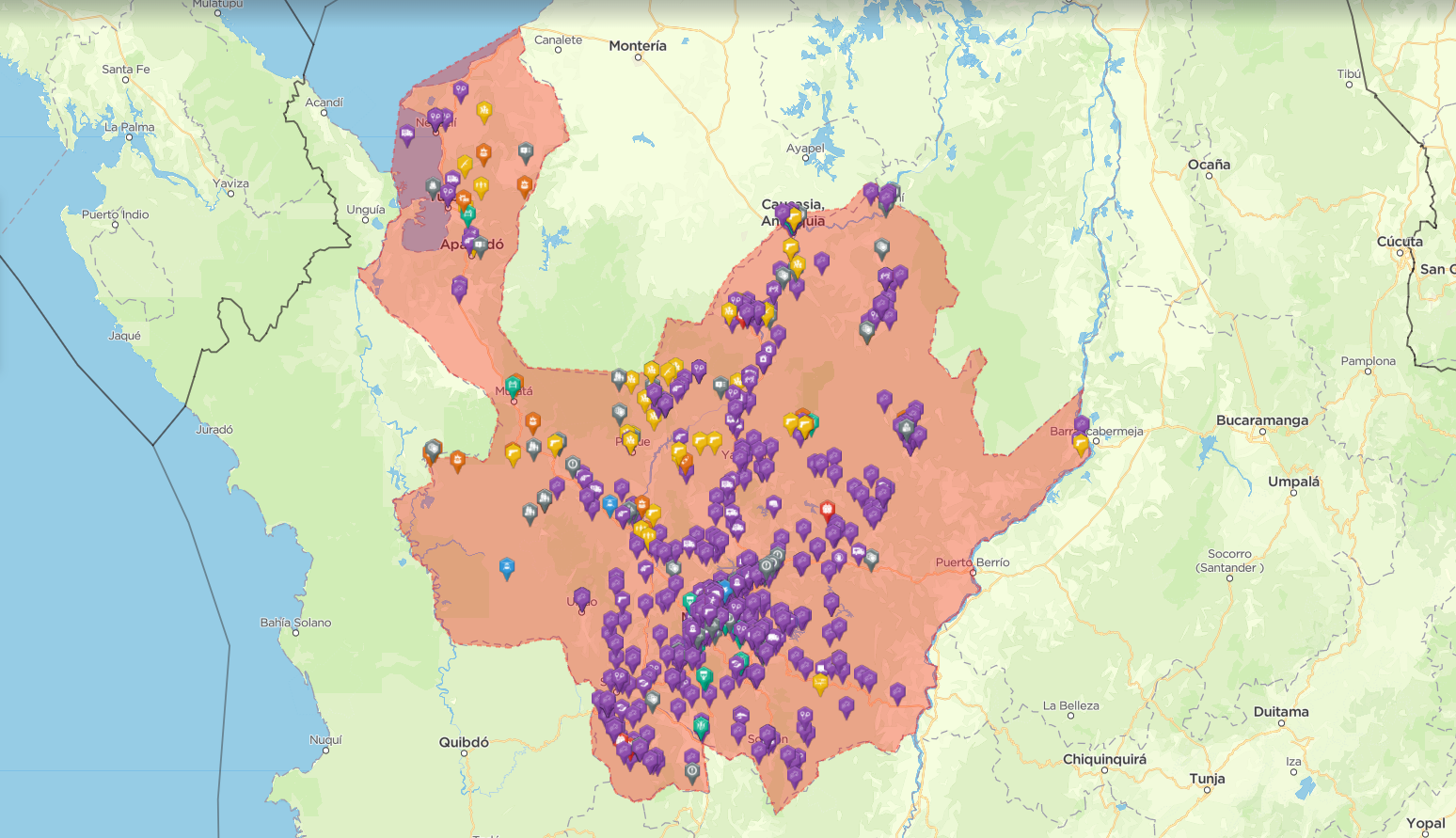
Incidents of criminality and conflict across the Department of Antioquia in 2021 [image source: Intelligence Fusion]
Crime and Security in Medellin
Medellin, the capital of the department of Antioquia, is the second largest city in Colombia with approximately 2.5 million people as of 2020, up to 3.7 million if we count the wider metropolitan area. It is not only the economic hub of the department, but also contributes to a significant portion of the country’s GDP. As such, it is the area where Intelligence Fusion recorded most incidents throughout 2021 regarding the department.
While security and crime-related incidents make up the bulk of reporting in Medellin, protests are also common, consisting of not only large peaceful marches, but rioting and vandalism too. Two areas were particularly targeted in 2021, the area near Parque de Las Luces and the area near the University of Antioquia – Medellin.
The area near the Parque de Las Luces is across from the complex where the Medellin City Hall, the Government of Antioquia and the Palace of Justice are all located. The location leads to all types of protest actions, from social causes such as animal rights, to more economic and political causes, such as teachers on strike for better salaries and working conditions. The area saw peaceful demonstrations, as well as roadblocks and riots during the year.
The area around the University of Antioquia also saw significant protests, particularly at the Parque de Los Deseos, where several anti-government marches were launched in May 2021 to denounce the government’s proposed tax reforms and other policies, with additional protests in June and July. The second area that saw significant activity near the university is Calle 67, near the corner with Carrera 53. Riots, roadblocks, and vandalism have been reported at both areas, likely due to the location of the university and the participation of students in the protests. Vandalism has targeted financial institutions, as well as public transport infrastructure.
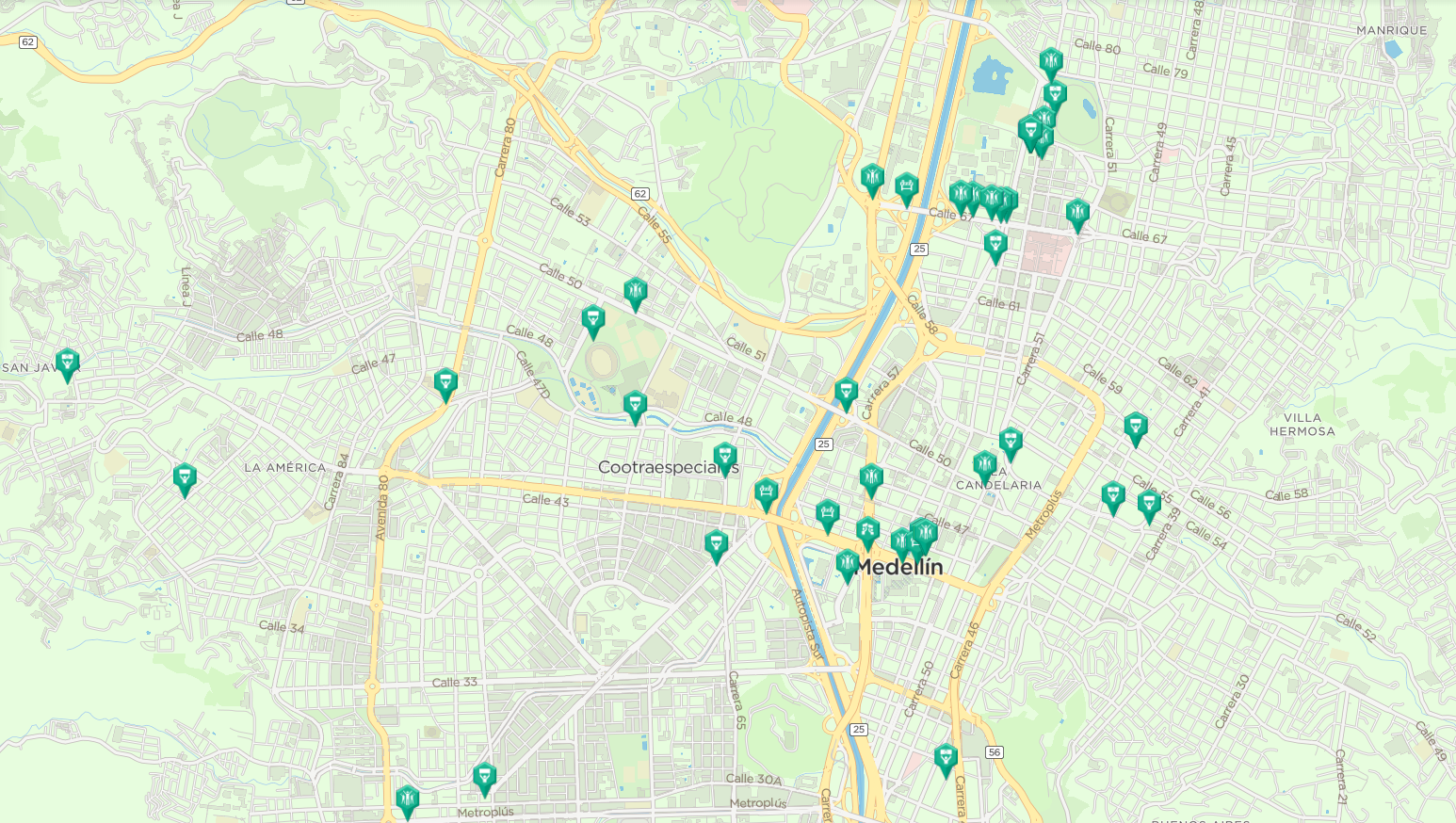
Incidents of protests across Medellin in 2021. Area in central Medellin and near the University of Antioquia – Medellin are prominent in areas affected. [image source: Intelligence Fusion]
Clashes between the protesters and riot police reportedly led to dozens being killed, thousands injured and more than 1,500 people arbitrarily detained. After protests dissipated after several months, authorities launched a series of raids targeting members and alleged members of the Primera Linea, a loose protest collective, who was present at protests.
Regarding crime, homicides are the most recorded crime by Intelligence Fusion in Medellin, however other crimes such as armed robberies, thefts, and non-fatal shootings and stabbings, have also been recorded across the city. The commune of La Candelaria in central Medellin has seen significant numbers of incidents, with fatal stabbings common. Several muggings were also recorded, including in the Plaza Botero. Police in Medellin are concerned with the 10% increase in fatalities during robberies that has taken place this year. In addition to muggings, across Antioquia there have been 118 homicides of women by the end of November 2021, of which 29.5% took place in the Aburra Valley region where Medellin is located. Criminal gangs vying for control of the drug trade is a common motive for violent crime in the city, with tandems on motorcycles conducting drive-by shootings a common tactic.
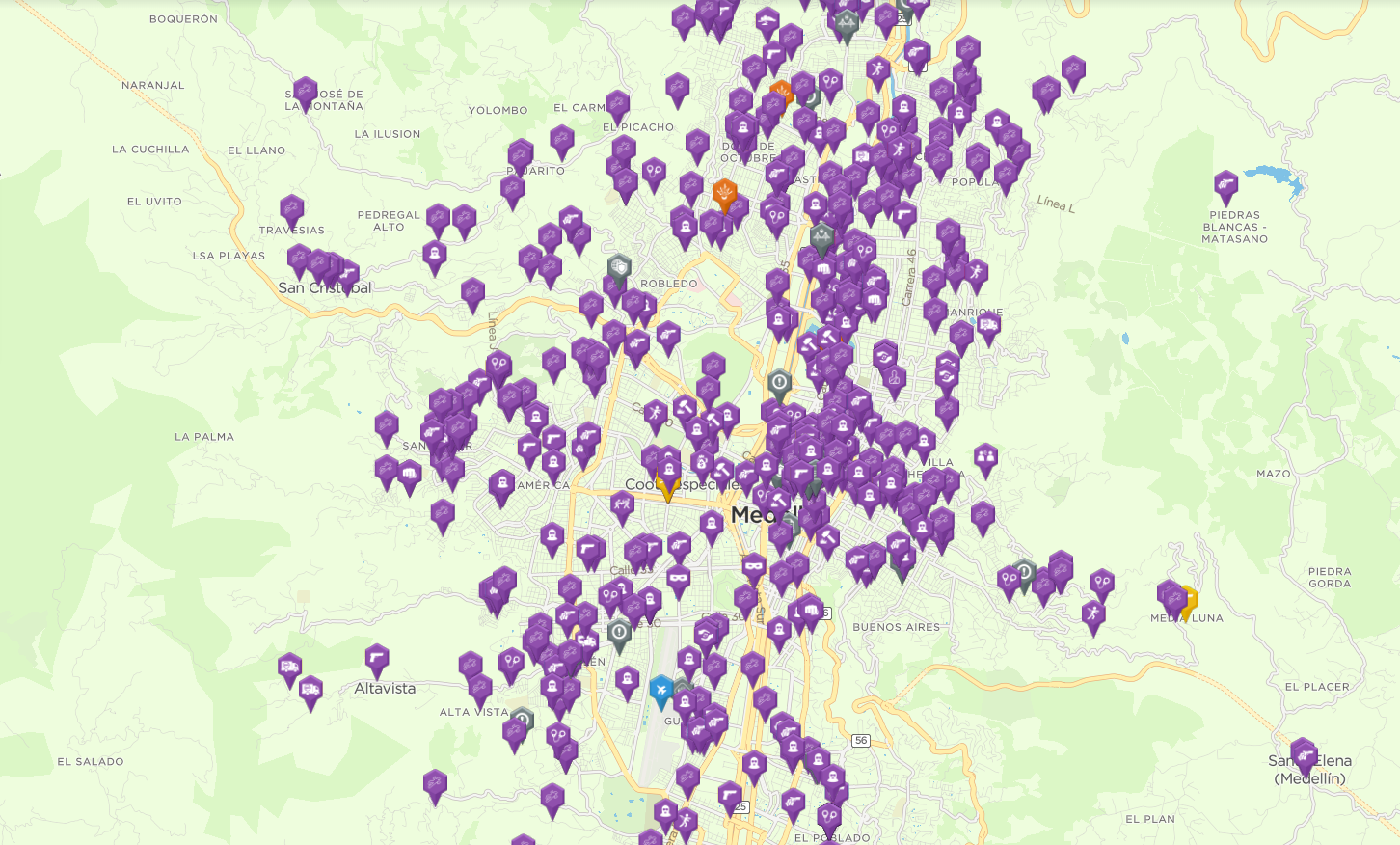
Incidents of crime across Medellin in 2021. Crimes most often recovered are murders, small arms fire incidents, stabbings, armed robberies and thefts. [image source: Intelligence Fusion]
Whilst protests are likely the type of incident most likely to impact a traveller to Medellin, there have been instances during the year of foreigners targeted by criminals. In March 2021, an Israeli tourist was robbed by 2 suspects in the El Poblado area of Medellin, with his Rolex, gold chain and several cell phones stolen from him. The two suspects were Venezuelan nationals, and both were arrested during their escape. In November 2021, a German national who was part of a group of athletes in the Arvi Park in Medellin was also robbed at gunpoint, with electronics and clothes stolen. While the victims were unharmed in these instances, there has been at least two cases of a fatalities.
In May 2021, a Canadian merchant was shot and killed in the Aves Maria neighbourhood of Sabaneta in the Metropolitan area of Medellin. The man was shot by two motorcycle-riding gunmen after coming to the area two months prior to expand his business. In September 2021, a Czech national on holiday with her British boyfriend was shot and killed 2.5 hours south of Medellin in Jardin. Jardin is an area being contested for by several armed groups. The deaths are a reminder that while rare, the threat to foreign nationals is still present, and travellers should take precautions in the areas and times at which they travel.
Armed Groups and Conflict in Medellin and the Department of Antioquia
While Medellin sees most crime related incidents connected to criminal gangs, the rural areas of the department of Antioquia sees its incidents connected to the activities of illegal armed groups including the Clan del Golfo, the ELN, FARC dissidents, and other smaller groups. These groups are fighting for control of several criminal enterprises, and the levels of violence used are high.
The groups have been able to operate in northern and southwestern Antioquia due to state neglect, which has allowed armed groups to control large swathes of territory. Northern Antioquia is of importance due to the drug producing areas of the department, and the drug routes that pass through the Nudo de Paramillo Mountain range, as well as through the mountains to the port of Turbo and the port of Cartagena. The growing of coca in the department has also led to an illegal logging industry, as armed groups pay individuals to clear cut land for coca growing to take place. This has led to problems of deforestation in not only Antioquia, but other departments where coca growing is prominent. Illegal armed groups are also involved in illegal mining in the department. The activity, whether through the control of mining areas or the taxing of artisanal miners, is used to fund the groups. Like coca growing, the activities have detrimental effects on the environment, and 2021 saw several joint operations by the armed forces and the police to destroy illegal mining equipment and dismantle operations.
Conflict related icons (yellow and orange) show that the activities of illegal armed groups are concentrated in the northern municipalities of the department of Antioquia. Several skirmishes between armed groups and with government forces have been recorded on the border of the departments of Antioquia and Cordoba, while additional activity such as the use of anti-personnel mines have been recorded on the border of the departments of Antioquia and Choco where armed groups fight for control of drug routes towards Panama and the Pacific. [image source: Intelligence Fusion]
Due to these activities, the levels of violence are significant in several municipalities in northern and southwestern Antioquia, including Andes, Betania Caucasia, Ituango, Segovia, and Taraza among others. The municipalities of Andes and Betania were the sites of three mass murders during the year – February, April, and October – which led to the deaths of 15 people and wounded one other. At least one of the murders was attributed to the Clan del Golfo, who at the time were fighting for control of southwest Antioquia against the Oficina de Envigado – a criminal group based in Medellin – and the ELN to secure drug routes to the Pacific Coast via the department of Choco.
Most of the heavy fighting, involving skirmishes and the use of mines and other explosive devices has been recorded in northern Antioquia on the edge of the department of Antioquia and Cordoba, in the municipalities of Ituango, Taraza and Caucasia. These skirmishes have involved both Clan del Golfo members and FARC dissidents. The use of explosives was prominent in the municipality of Murindo, on the border with the department of Choco, where the ELN is suspected of placing anti-personnel mines in coca growing areas on indigenous lands, which has led to both civilian and government casualties.
Several military and police operations were undertaken throughout the year, not just to combat illicit enterprises of these armed groups, but also to capture high profile members of the groups. One of the biggest achievements of the year was the capture of Dario Antonio Usuga, alias ‘Otoniel’, of the Clan del Golfo, although his capture, while touted by the government, has also brought doubts to the public, as ‘Otoniel’ claims he surrendered to the authorities voluntarily. Soon after the capture, several attacks took place against soldiers and police officers in several areas of the department, believed to be retaliation by the Clan del Golfo.
Will the security situation change in 2022?
The United States’ State Department, as of December 2021, placed Colombia under Level 3 travel advisory, which asks travellers to reconsider travel to Colombia due to not only Covid-19, but also crime, civil unrest, terrorism, and kidnapping. Several departments – Arauca, Cauca, and Norte de Santander – have been placed under the ‘Do not travel to’ list due to the activities of armed groups. It is unlikely the rating will change in 2022.
Medellin Cartels in 2022
The department of Antioquia will almost certainly see similar levels of violence to 2021. One key aspect of how that violence plays out, particularly in rural areas outside of Medellin, is what will happen with the capture and future extradition to the United States of alias ‘Otoniel’ of the Clan del Golfo.
The structure of the Clan del Golfo is more horizontal than vertical, and some factions will likely continue to operate under the umbrella of the group, while others will attempt to branch out on their own. However, there is a possibility that with no definitive leader, it will create a power vacuum which will lead to an increase in violence between various factions.
Violent Crime in Medellin in 2022
Violence in Medellin will also likely not subside without significant actions by local law enforcement. Covid-19’s impacts on the economies of countries and cities has also been felt in Medellin, affecting the youth, and allowing for criminal groups to exploit such situation by recruiting. The city’s Deputy Security Secretary has stated he believed the city had at least 3,000 active gang members, operating for dozens of gangs.
Activities will continue to include homicides, armed robberies, thefts, and extortion among others. It is not likely that foreigners will be sought out as targets, but like any country, being prudent and avoiding showing outward signs of wealth is recommended.
Political Instability in Colombia in 2022
Finally, of note in the next year is the presidential election planned for May 2022. The results of the election may impact the activities of armed groups in the second half of the year, depending on the winner of the election and their stance on implementing the 2016 peace accords and on combating groups such as the ELN and Clan del Golfo.
At least one candidate, Juan Manuel Galan, proposes to end the war on drugs through increasing state presence in rural areas, both using military forces and economically, to push out criminal groups. Such a strategy would likely lead to significant armed confrontations between government forces and armed groups looking to hold their territory, including in Antioquia. It is unclear at this time who could win the race, but whoever does will inherit a delicate security situation which will have to be addressed for development and stronger economic gains to be had.
In the most recent episode of The Roundtable, an Intelligence Fusion podcast, our team take a closer look at the under-reported armed conflicts that pose a significant threat to security in 2022. Medellin, as well as the border region of Colombia and Venezuela, are discussed as part of the wider conversation.
Our podcast series is available on all major platforms including Spotify, Apple Podcasts and Amazon Music.
If you’d like to take a closer look at the data that supports our analysis, schedule a demonstration of our threat intelligence platform. Providing timely, accurate incident data to security teams across the world, we can help you to better protect your people, assets and operations in times of uncertainty.
